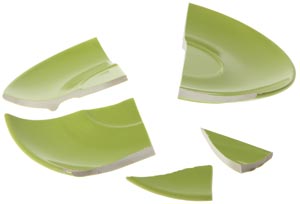
I saw it coming.
My daughter emptied the dishwasher dangerously fast. I did not need to be a “mind-reader” to see that she did not like the job. But—it had to be done, and it was her job. So she stacked the dishes precariously high, ready to be packed into the cupboard on the other end of the kitchen. And then the inevitable happened. A plate slipped off the stack and crashed to the floor, breaking into about a thousand pieces. The plate was history. My daughter looked with big (and worried) eyes.
As an archaeologist I appreciate the value (and fragility) of pottery. Different pottery styles help determine a sequence, which in turn aids in the often difficult task of dating a specific stratum. Since everybody needed to eat and drink and cook, pottery finds are the most common in any excavation. Pottery production was relatively cheap and reflected the style and technical capabilities of a given period.
 Cheap—yet valuable! That somehow rang a bell as I looked at the many pottery fragments strewn all over the kitchen floor. Paul expressed it like this: “But we have this treasure in jars of clay to show that this all-surpassing power is from God and not from us” (2 Cor. 4:7). Or as The Message paraphrase puts it: “If you only look at us, you might well miss the brightness. We carry this precious Message around in the unadorned clay pots of our ordinary lives. That’s to prevent anyone from confusing God’s incomparable power with us. As it is, there’s not much chance of that. You know for yourselves that we’re not much to look at.”*
Cheap—yet valuable! That somehow rang a bell as I looked at the many pottery fragments strewn all over the kitchen floor. Paul expressed it like this: “But we have this treasure in jars of clay to show that this all-surpassing power is from God and not from us” (2 Cor. 4:7). Or as The Message paraphrase puts it: “If you only look at us, you might well miss the brightness. We carry this precious Message around in the unadorned clay pots of our ordinary lives. That’s to prevent anyone from confusing God’s incomparable power with us. As it is, there’s not much chance of that. You know for yourselves that we’re not much to look at.”*
Who would put a treasure in a fragile clay pot? Who would hang a Rembrandt in a smelly cow barn? God did, Paul says, not because of anything inherently great in us, but to show us that whatever is good in us is God working in us. The Creator and Redeemer chooses a paradox because He wants us to live the treasure-way.
Paul continues with four more paradoxes in verses 8 and 9: “hard pressed . . . but not crushed; perplexed, but not in despair; persecuted, but not abandoned; struck down, but not destroyed.” Yes, as human beings we stagger on the brink of (self-)destruction—every day. We disappoint, we hurt, we are knocked and battered, and yet, there is this unexplainable treasure in us that keeps us going. The painted over, long-lost, partly defaced image of God whose restoration begins from the moment we say yes to our Lord and Savior, who is transforming the frail, brittle clay vessel into a new creation.
We are not just an empty vessel, however. Paul includes one more important element: “We always carry around in our body the death of Jesus, so that the life of Jesus may also be revealed in our body” (2 Cor. 4:10). The secret is Jesus in us. We are valuable vessels—because Jesus died for us, rose for us, and continually works in us.
So here is the deal: notwithstanding how you may be feeling today, in spite of the mess that we undoubtedly are, you (and I) are a treasured participant in the great battle involving God’s character. He has chosen you (and me, and a whole bunch of other people) to demonstrate to the universe what it means to be a “new creation.” We are His exhibit A (and B through Z) that a proud Father shows to the accuser of the brethren and sisters. A treasure in a fragile clay pot—Jesus living in us.
We are loved, we are wanted, we are forgiven, we are being transformed, we are His—and that’s enough for today (and tomorrow).
_________
* Texts credited to Message are from The Message. Copyright © 1993, 1994, 1995, 1996, 2000, 2001, 2002. Used by permission of NavPress Publishing Group.
____________
Gerald A. Klingbeil is an associate editor of Adventist Review. This article was published June 21, 2012.